At Mundo we are especially proud to present our Panama country focus. This country means a lot to Mundo for different reasons. Of course it is one of the best places to do business in the world, it does have a unique territorial tax system, free zone regimes with incredible advantages and the possibility of establishing a foundation similar to Lichtenstein´s but at a much lower cost.
But Panama is much more than money, although here you can make a lot and save a lot in taxes, like our friend from Canada did (see our Expat Living in section below), Panama means friendship, comradery and companionship. In Panama, no expat feels alone, because we live in an international cosmopolitan environment where nobody will look down on you because of your race or religion, and where you can always find a community that will support you and understand you.
This amazing adventure called Mundo started in Panama, this is where some of the main members of the editorial team met for the first time and dared to dream the same dream that we are now seeing materialized before our eyes. Our dream was and is to create a web portal where experts, clients, writers, freethinkers, perpetual travelers and nomad capitalists can coexist in a friendly environment, exchange ideas and points of view and access unique business and investment opportunities through our network across the world.
In this country focus we present our favorite country for business and for life.
Read along and embark in this wonderful adventure with us!
History
Like the philosopher George Santayana said, “he who does remember the past is doomed to repeat it”.
For this reason, we decided to start with a glimpse to
Panamanian history.
Panama has a strategic location and has been known for being an especially important maritime trade center. The early Spanish conquerors used to transport minerals from Peru to Spain via the Panama isthmus. Thanks to this many port cities were formed along the Panamanian coasts, home to both native Panamanians and Spaniards.
The first economic boost of the region was in the 19th century during the gold rush, when there was a significant increase in traffic. Nevertheless, this increase of traffic did not help the industrial development, as they were receiving commodities and services straight from the United States. When the first transcontinental railroad was built in the United States, Panama´s popularity as a travel destination and trade route started to decline. This would have been the end of the economic and financial development for Panama if it wasn´t for the fact that the world´s major economic powers considered convenient to build a canal through the Panama isthmus. The construction of this canal was started by the French but soon the United States took over after Panama separated from Colombia in 1906.
The construction of the Panama Canal was finished in 1914, and soon after this it became a major spot for international trade and commerce. The rest is history. Panama enjoyed a period of stability in the 20th century until the government of Noriega in the 80´s. After the deposing of Noriega in 1989, during the 90´s and the turn of the 21st century and up until today, Panama´s economy experienced a constant growth and it finally became one of the major financial hubs of the region and also of the world.
Being the home of the Panama Canal, this country has enormous financial and economic advantages.
.jpg)
One of the freest countries in the world
Many times, Panama has been given nicknames such as the “Singapore of the Americas” or “the “Switzerland of the Americas”.
The reason for these comparisons is that Panama presents some conditions which make it a unique country, where individuals can enjoy a variety of different advantages.
We present five reasons why Panama is considered to be one of the freest countries in the world.
1-At the crossroads of the Americas
Due to its unique location, Panama attracts many foreigners.
If you want to invest in Panama, you can easily manage your business here and still be not so far away from your home country.
For this reason and for other advantages as well, many wealthy people from other Latin American countries move to Panama escaping from the economic problems and inflation issues of their home countries. This is the case of Argentina and Venezuela, for example.
Panama also uses the US dollar as currency, and the government is not planning to issue its own currency any time soon.
However, Panama is not only interesting for Latin Americans but also for many Europeans, who run away from their high taxation and highly controlling governments to a safer haven and a nicer weather.
From the exotic land of Asia, we also receive expats and investment flow. The relations between Panama and China have been growing during the last 5 years. A large flow of Chinese capital has come to Panama in the form of various investments and the Chinese community is getting stronger. The president of China has even visited Panama himself and has approved a 14-billion-dollar investment in infrastructure. Chinese banks are opening their branches here and the most important real estate developer has implemented projects.
2-Open to foreign investment
Being a small country in and of itself, Panama has practically no other choice but to attract foreign investors in order to boost the economy.
For many years, the country has been a safe place for investments and business.
Given the fact that Panama has limited resources, it is safe to say that it is surviving thanks to foreign capital and investment. This will continue being this way most certainly for a long period of time.
3-No central bank
Many people consider Panama to have a stronger property rights regime than the United States themselves.
Panama has proven than a country can survive and even flourish while having a decentralized economy.
The country doesn’t have a central bank, and it hasn´t had one since its independence over a hundred years ago. Panama has no currency of its own besides from a few coins who intend to imitate the American ones. The currency that is widely used is the US dollar.
In general, the economy of Panama is good, and some surveys indicate that the inflation here is even lower than in the United States.
4-No Military
Panama is one of the few counties in the world which don´t have an army. It has the Panamanian Public Forces instead, which acts as police force.
Panama is a good example of a country which has learned the lessons from the past and now maintains good relationships with other countries in the region and in the whole world.
5-No history of civil war
Ever since the civil war which lead to independence, Panama has no history of civil wars at all.
In this country foreigners can enjoy great freedom like free press, free speech and freedom of religion and cult, and live in a country whose government supports immigration. A clear example of this is the wide variety of residency visas that Panama offers, being one of them actually one of the easiest-to-get residencies in the whole world.
Naturally, Panama also has some flaws. Being a Latin American country, it sometimes falls into some unpleasant stereotypes like slow customer service.
If you like things done fast and efficiently, Panama may not be the right place for you to live, but you can always invest here and conduct business, while living or spending most of your time someplace else. You only have to spend a few days in the country every two years to maintain residency.
All in all, in the last few years Panama has been– and it continues to be – a hub for investors and businessmen from Latin America and other parts of the world.

Great lifestyle at a low cost
One of the reasons why expats from around the world choose Panama is because this country offers a developed infrastructure and first world amenities, similar to those in the US but at a much lower cost.
In Panama a little money can buy you a fair deal of luxury. In some regions a person can easily live on 1,000 USD a month, and at the same time enjoy the company of friendly locals and other expats, pretty landscapes, and great beaches.
Moreover, and thanks to the fact that Panama is a small country, you can enjoy a quiet lifestyle while being not too far away from the capital city. In places like Los Santos or Herrera, for example, you can easily find property near the beach for only $60,000.
In other words, Panama offers the California-type lifestyle many can only dream about at a much lower cost.
The best place to retire
What to eat in Panama?
Who wouldn’t love to enjoy a fine cocktail while lying on a swinging hammock, a delicious fried fish meal with a cold beer, or a seafood dish with a delectable mango juice?
Panama is not only known from being a business hub but also from its exquisite and diverse cuisine.
Panama means literally “abundance of fish”, which is probably the reason why there is such a wide variety of fish and sea food in the country.
Corvina is the most popular fish in Panama and you will find it practically in every restaurant where it is often served with garlic and butter.
The corvina is also used for the preparation of the popular ceviche, a meal whose popularity is well spread throughout the Pacific coast. In Panama you will find ceviche made of octopus, shrimp, fish, and a combination of these.
On the Caribbean coast of Panama, bacalao is extremely popular, usually served with vinegar and hot peppers.
For obvious reasons fish and sea food are the main protein here, but it is also quite common to find chicken and meat-based dishes. Some popular meals include pounded beef with onions and “tamal”, which are bundles made of steamed corn and meat wrapped in banana leaves.
Tubers like the yuca and the potato are widely consumed in Panama, being used in soups like the “sancocho”.
One of the most popular meals in Panama is the “arroz con pollo”, literally meaning rice with chicken, and the coconut rice which is a typical meal of the Caribbean region.
In Panama there are also many choices for vegans and vegetarians. A typical Panamanian meal includes not only meat but also a variety of beans and vegetables.
One of the most popular side dishes is “patacones”. Patacones are plantains which have been sliced, smashed, and fried and are usually served as a side dish to fish and meat-based meals.
Let´s not forget about fruits, which exist in a wide range of shapes and colors in beautiful Panama. The pixbae, for example, is a typical local fruit which holds many nutrients and vitamins. It is usually served as a snack or added to salads, soups, and croquettes.
In Panama you can get inside any market and you will find a wide range of delicious, juicy, and nutritious fruits such as mangos, pineapple, bananas, plantain and papayas.
Fruits are quite easy to find here in Panama and at very convenient prices. In this country sometimes fruits are even more accessible and easier to find than fast food.
It is time to talk about beverages now. Panama´s most popular drink is the Ron Abuelo, which has won gold international medals for its excellent quality. Another typical spirituous beverage is the seco herrerano, which is a strong hard liquor distilled from sugar cane. It is usually mixed with cranberry juice. It is safe to say that the seco herrerano is the “Panamanian vodka”.
Panama is also known for its national beers. Panamanian beers tend to be light and are very inexpensive. Some of the most popular brands are Atlas, Panama, and Balboa. There are also excellent choices for craft beer such as Rana Dorada and Casa Bruja.
To sum up, the gastronomic variety in Panama is utterly amazing, offering a wide range of options for all tastes and preferences. The colorful and delicious Panamanian cuisine, along with its fresh natural products, give both locals and expats a chance to enjoy tasty and at the same time healthy meals.
Panama´s most important cities
Panama offers a wide variety of entertainment and opportunities. Many come here purely in search of adventure, while others see Panama as an advantageous business destination and financial hub.
The bottom line is that no matter what your preferences and interests are, in Panama you will find what you are looking for.
Here are is a summary of Panama´s most interesting places and cities.
Panama City
Panama City offers a cosmopolitan, first-world-city lifestyle very similar to the one you may find in cities like San Francisco or Miami, but at a much lower cost.
This interesting city hosts nearly 80 of the world´s largest banks as well as giant international companies and it´s a major commerce, financial and banking center. Many expats find in Panama City first class health care, high speed internet and reliable power and water supplies.
Moreover, the capital city is one of the main culinary destinations of the region, offering a wide variety of sea products and also an exquisite international cuisine.
Cost of living in Panama City
Although Panama City is the most expensive city in Panama, it is still cheaper than the United States and Europe, especially if you consider that Panama is a world capital and the most important financial center of the region.
If you decide to live in Panama City you may consider not buying a car. The subway here costs only $0.35 and most bus rides only $0.25. There are also inexpensive transportation apps such as Uber, and a ride on a regular taxi usually doesn’t cost more than 4 or 5 dollars.
We present a simple budget where you will find details of estimative monthly expenses in Panama City:
|
Expenses |
U.S. $ |
|
Rent (two-bedroom
apartment in a central area) |
$1,000 to $1,500 |
|
Transportation (taxi or
fuel/maintenance on a compact car) |
$75 to $200 |
|
Electricity (depending on
air conditioning use) |
$60 to $150 |
|
Water (bundled with trash
pickup) |
$0 to $25 |
|
Gas for cooking, water
heaters, dryer, etc. |
$0 to $10 |
|
Supermarket
(food/household, mix of local and imported items) |
$400 to $500 |
|
Entertainment for two
(movies twice a month, including snacks/drinks, and dinner four times a
month) |
$150 to $400 |
|
Phone (land line, mostly
local use) |
$13 to $20 |
|
High speed internet |
$20 to $45 |
|
Cable or satellite
television |
$35 to $50 |
|
Monthly total for a
First-World lifestyle in the big city: |
Approx. $1,753 to $2,900 |
Costs are low also for entertainment. Movie tickets in Panama cost about $6, and a combo with popcorn, nachos and a soda may cost just as much. Most films are played in the original language with Spanish subtitles.
Lifestyle in Panama City
Panama City is appropriate for most lifestyles, offering from ultra-modern skyscrapers like the ones you may find in a thriving financial center, to quite neighborhoods you may easily find in small towns.
There is also a wide variety of restaurants in Panama City, where in some cases you can have lunch for $7 or $10 and a beer for as little as $1.
When you think of the luxuries you have denied yourself during your life, it is not bad to think of the life style you may have in Panama, where you can maybe play golf on a regular basis, afford weekly massage sessions, and go out to fancy restaurants more often than you did back home.
Bocas Del Toro: Panama’s Caribbean Gem
Bocas del Toro may very well be considered a secret Caribbean gem, as it is a destination unknown for many. Near the border with Costa Rica, Bocas del Toro is part mainland and part archipelago.
Only one-hour flight away from Panama City, in Bocas del Toro you will find yourself in a totally different world, surrounded by hundreds of islands, some of them completely uninhabited.
Bocas del Toro is a true Caribbean paradise, with turquoise waters, white sand and coconuts growing from palm trees. Although the Caribbean has two times the rainfall than the Pacific coast, this continues to be a popular touristic destination among Panamanians and foreigners as well. This region, like the rest of Panama, is completely outside of the hurricane belt and is visited by different kinds of tourists. In Bocas del Toro you will find long term backpackers, surfers, families, bohemian people, and also wealthy individuals vacationing in luxury resorts.
Also, in this region you will find a large community of expats, mostly in Isla Colon, in their mid-twenties, retirees and everything else in between. Many have started their businesses here and chose this place as their place of residency, living a laidback lifestyle in this magical Caribbean paradise.
Boquete, one of the top retirement havens
Boquete is a town located in the province of Chiriqui, in western Panama. It has a population of 6,000 people and a large community of retired expats, who moved there in search of a simpler and quieter way of life.
Boquete has long been considered one of the top places in the world to retire and this is not surprising at all.
This town enjoys a cool climate due to its location near the mountains, and its breath-taking landscapes attract both Panamanians and foreigners.
Boquete is located not far away, a 40-minute ride to be exact, from Panama´s third largest city, David. David is the commercial hub of the region, with the facilities and comfort inherent to all important urban centers. Boquete is also an hour ride away from the beach, which makes this town a unique place, where residents can enjoy a cool and nice climate while being close to the beach and to an important city at the same time.
Agriculture is especially important to the economy of this region. Rich and aromatic coffee beans are grown here along with citrus and oranges in particular.
For all these reasons Boquete remains one of the favorite destinations for expats in general and especially for those who are looking for a quiet retirement place. The perfect climate, the wonderful landscapes, the strategic location and healthy lifestyle options undoubtedly make Boquete a unique place where to enjoy life.
Real estate in Boquete
Besides from the fact that property prices in Boquete have risen during the last few years, real estate in this region is still affordable. There is a wide variety of options available, from modern houses to traditional cabins, with a broad spectrum of prices.
If you need help finding the perfect property for you in Boquete, you are welcome to contact us for a consultation with our real estate experts.
David, everything you need to know
David is the capital of Chiriqui province, and it´s the most important city of western Panama. This city presents a developed infrastructure and it is the most important commercial and business center of the region.
Many expats choose David as their place of residency due to the fact that the cost of living is much lower than in the capital, but still presents the advantages of a developed city.
David also has the highest temperature in all the country, for which it is known as the warmest city in all Panama.
Retire in David
David is also a great place for retirement. There is a well-developed infrastructure, high speed internet, excellent phone signal, accessible and affordable healthcare system and great connections. There is one flight to and from Panama City every day.
David also has a relatively low cost of living compared with other popular retirement havens. It has been reported that a couple can live here on only $1,400 a month. Moreover, the retirees, especially those who have a pensionado visa, enjoy the benefit of many discounts.
Chitre
The city of Chitre is the capital of the Herrera province and it has a population of approximately 80,000 people. Chitre is only a three-and-a-half ride away from Panama City and it´s the most important city of the region.
Expats can find here a variety of properties to fit every budget, from traditional one-story houses to modern apartments.
If you are worrying about finding what to do in Chitre, then worry no more. Chitre offers different entertainment activities from shopping to golfing and great restaurants.
There are other important expat communities not too far away from Chitre like Pedasi and Las Tablas.
The climate is one of the biggest advantages of Chitre, with average temperatures of 26-28° Celsius and lows around 21°.
Santiago
Santiago is the capital of the Veraguas province and it has a population of approximately 100, 000 people.
One of the main draws of this city is the Santiago Mall, which is the biggest mall outside of Panama City.
Due to the fact that it is located at an elevation of 299 feet, Santiago has a cooler climate in comparison with other cities in Panama. Nevertheless, the seasons are exactly the same as in the rest of Panama. Panama has only two seasons, dry and wet. The wet season begins in mid-April and lasts until December.
Demographics
Panama has a population of 4,314,000 people which grows approximately 1.61% per year. Panama is the 128th country in the world when it comes to population.
Thanks to the warm weather and the Caribbean lifestyle, and being one of the most beautiful tropical paradises, life expectancy is approximately 80 years for men and women together.
In 2019, the population density in Panama was 57 people per Km2 (148 people per mi2), calculated on a total land area of 74,340 Km2 (28,703 sq. miles).
Like in most countries, most people live in urbanized areas, being the percentage a 67.7%.
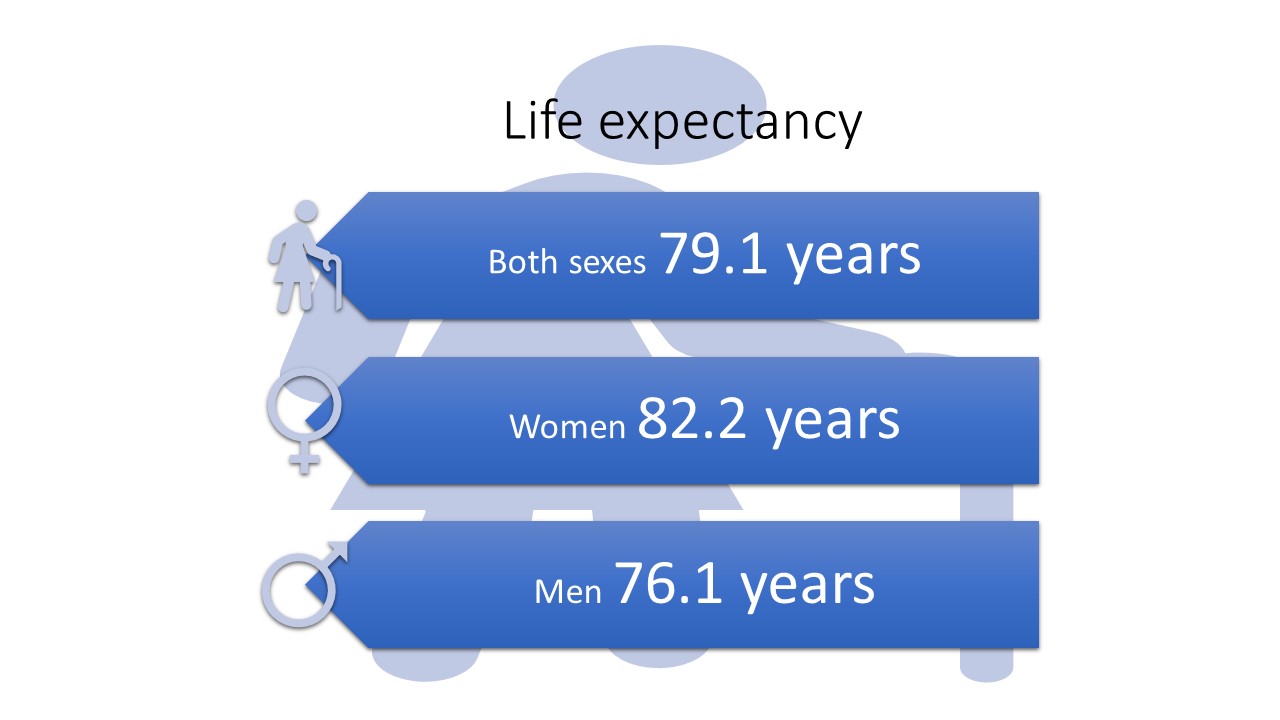
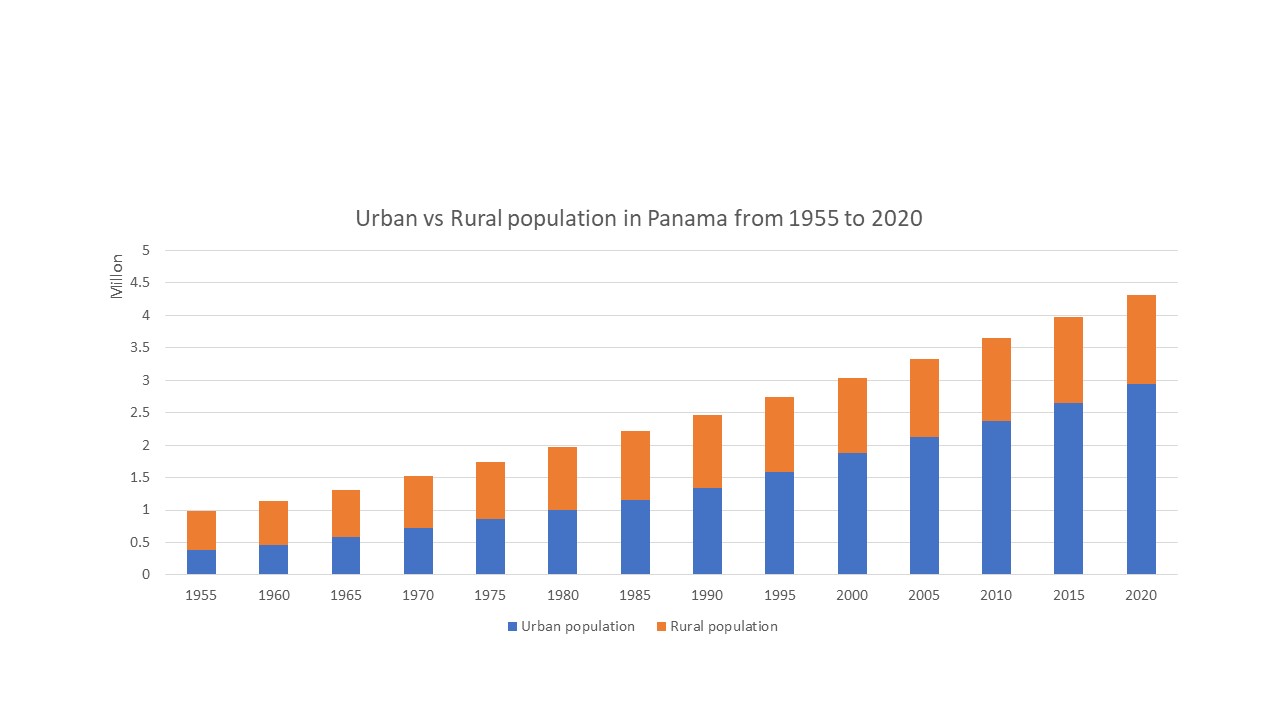
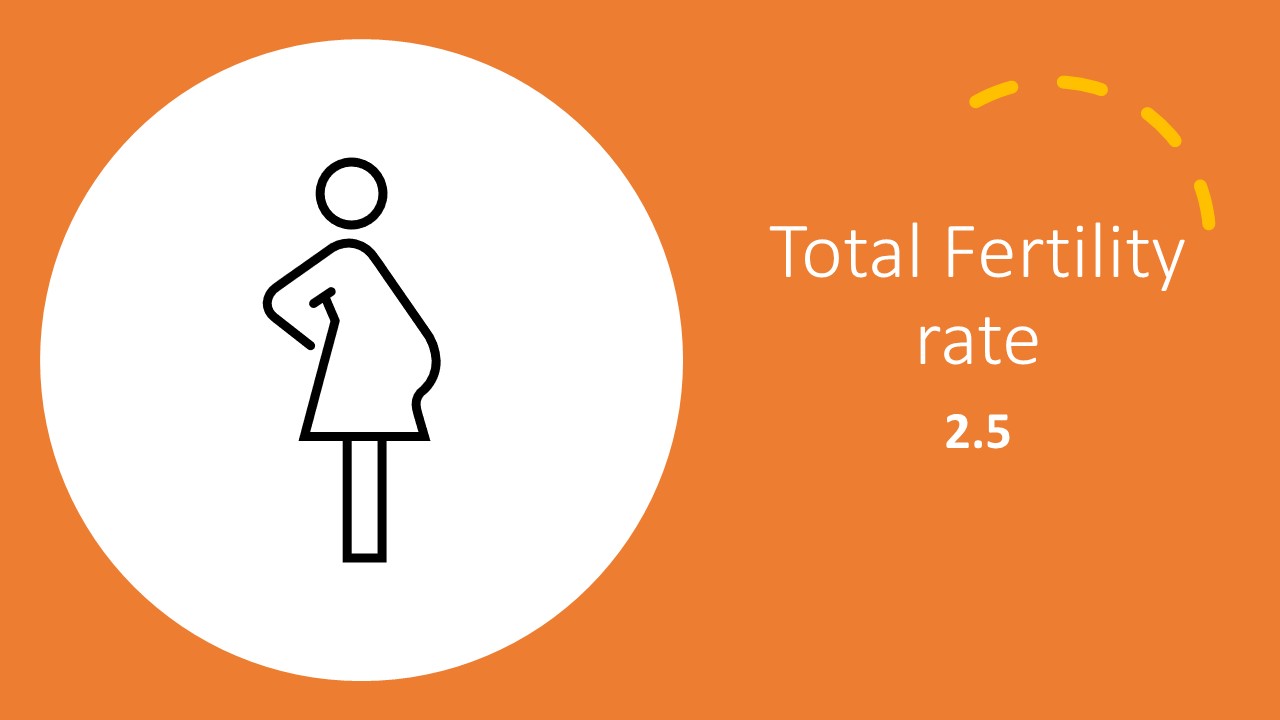
*A value below 2.1 would cause the natural population to decline.
*2.1 is the minimum value for generations to replace themselves without the need of immigration.
Due to its great appealing for locals and foreigners, the most populated city is the capital, Panama City, which has 408,168 inhabitants approximately. However, this doesn´t include the people who live in urbanized areas very close to the capital city like San Miguelito, Arraijan and la Chorrera.
Panama is called “crisol de razas” (mixture of races) due to its ethnical diversity. Panama is a little New York when it comes to culture with a 70% of mestizos, 14% Amerindian and mixed, 10% white and 6% Amerindian.
Panama has a large West Indian population and the reason goes back to the construction of the canal. During the 19th and 20th centuries, while the Canal was being built, the third part of the workers were Afro Caribbean immigrants from the West Indies.
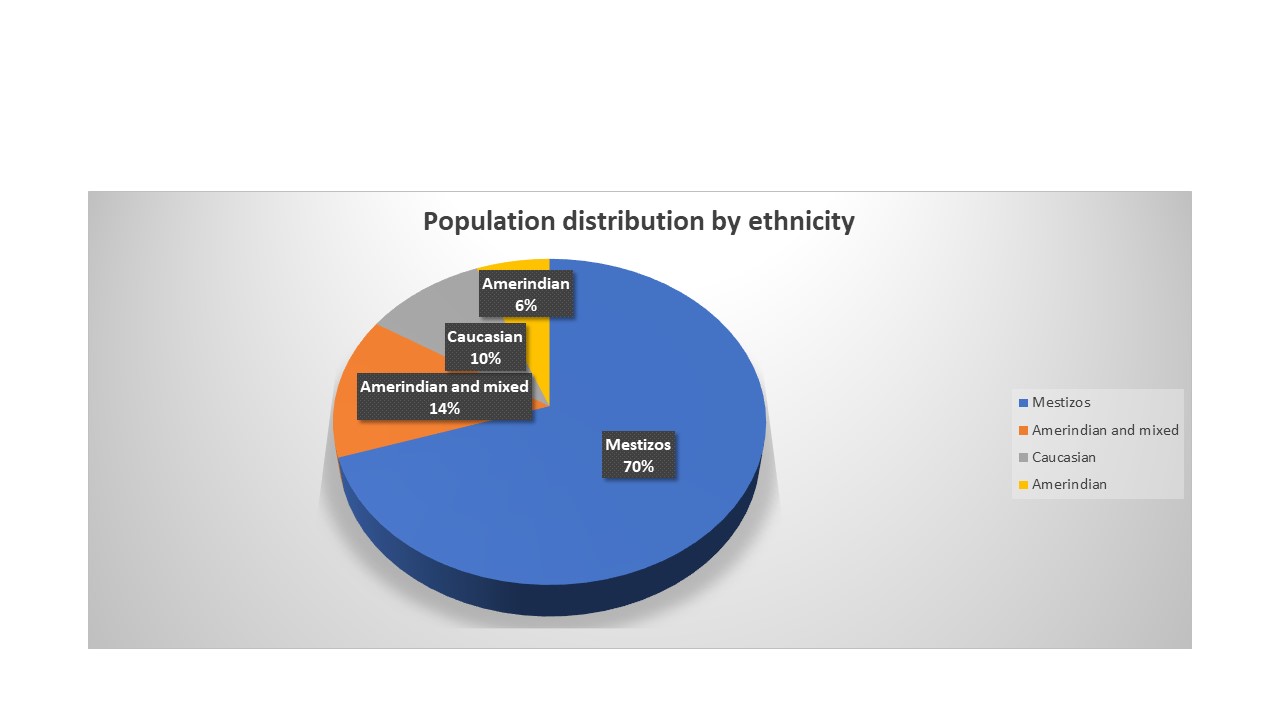
Religion
Panama is considered to be a tolerant country when it comes to religion and the constitution allows for freedom of cult. There are many religions in Panama, but most of the population, like in most of Latin America and due to the Spanish influence of the conquerors, practice some kind of Christianism. A survey carried out in year 2015 shows that 63.2% of people are Catholic, 25% are Protestant, 1.3% are Adventists, 1.4% are Jehovah's Witnesses, 0.6% are Mormon, 0.4% are Buddhist, 0.1% are Jewish, and the remaining 8% have no religion.
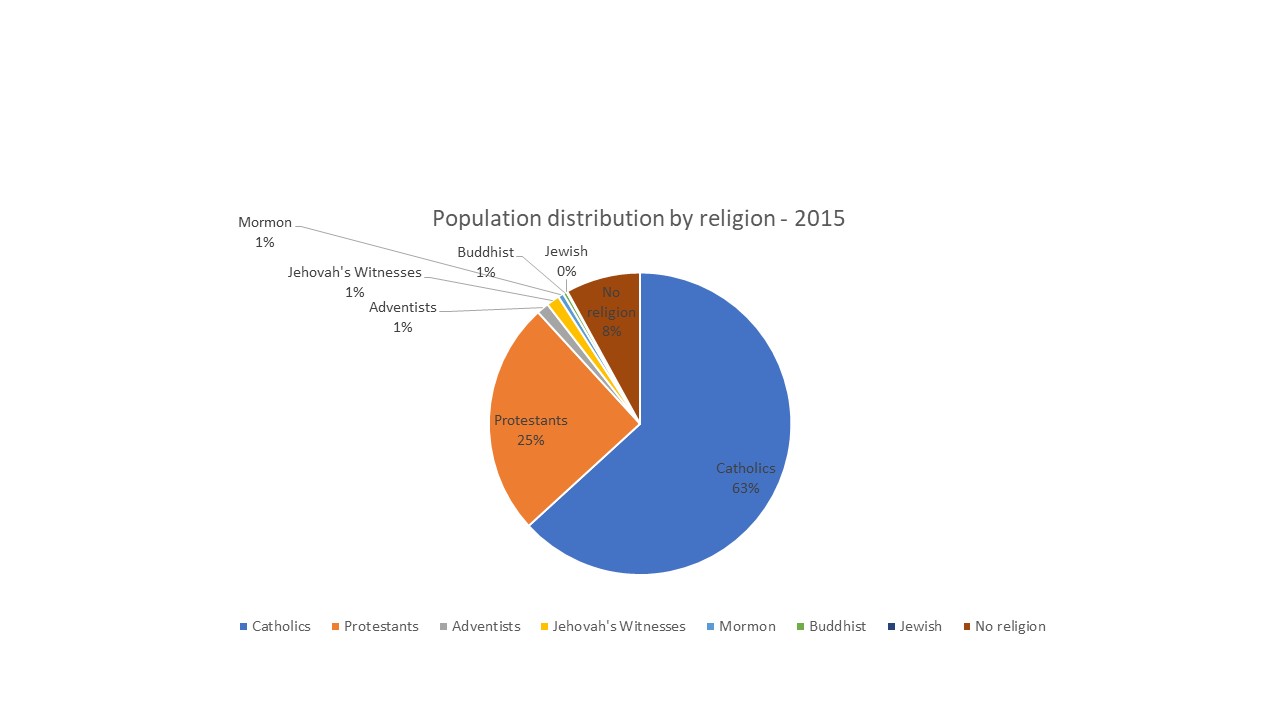
GDP and industries
The GDP of this country is mainly sustained by the services sector, which is mainly focused on financial services. The services sector accounts for 80% of the country’s GDP including banking and tourism services and commerce. The main industries in Panama include textiles, airplane parts and cement. Panama exports agricultural products like bananas, shrimp, coffee, sugar, and cotton.
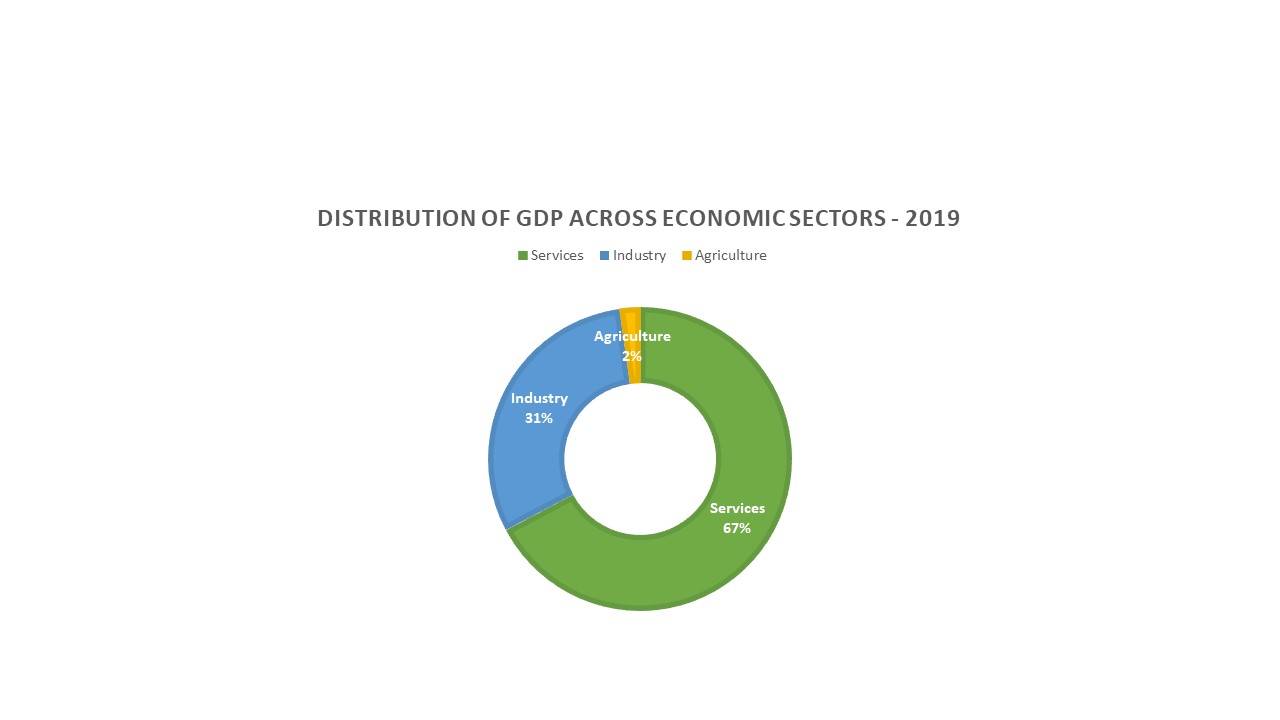
Panama’s GDP was worth 66.80 billion US dollars in 2019 and it has grown continuously since 2015, and the experts predict it will continue to grow. Panama’s GDP is expected to reach 68.50 billion in 2022. Here we share statistics showing how the GDP per capita was increased during the last 5 years:
2019- GDP per capita: $15,731, a 0.89% increase from the previous year.
2018- GDP per capita: $15,593, a 2.92% increase from the previous year.
2017- GDP per capita: $15,150, a 5.62% increase from the previous year.
2016- GDP per capita: $14,344, a 5.24% increase from the previous year.
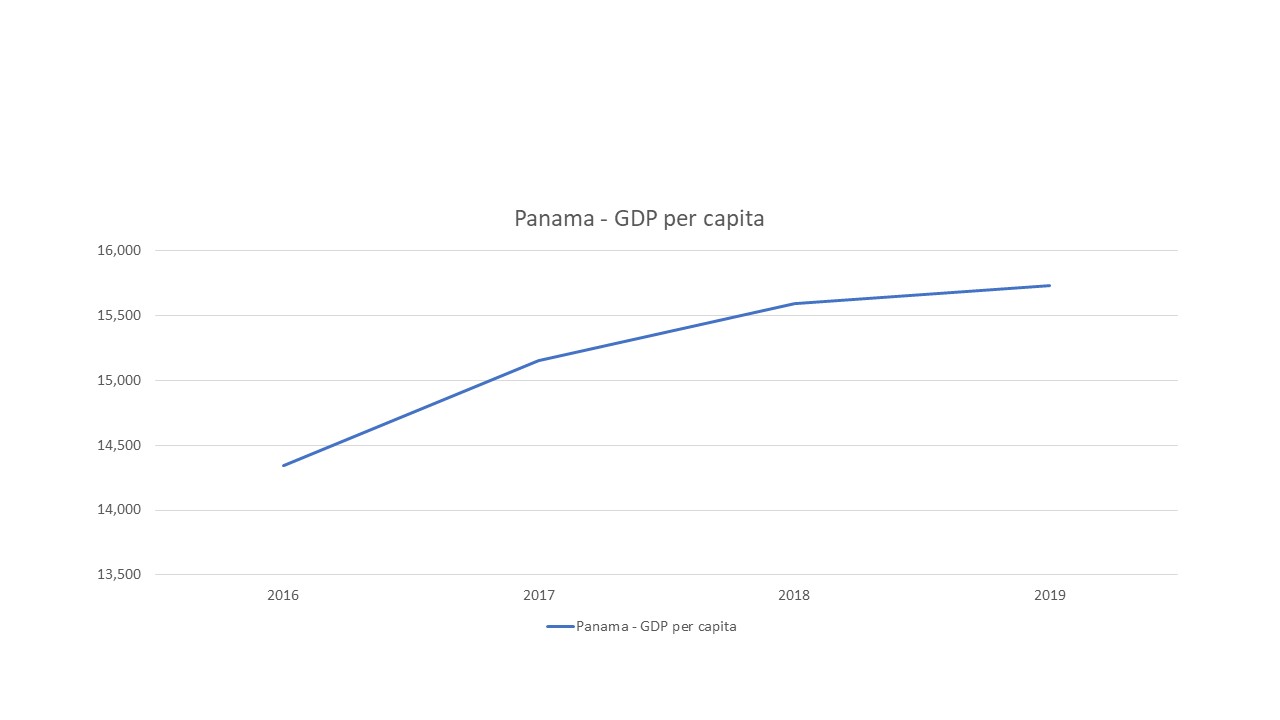
This growth in Panama’s GDP was achieved thanks to the prioritization of certain economic sectors such as logistics, tourism, agriculture, and financial services. Between 2007 and 2014, public debt decreased by 12.9% and this was the largest reduction in the Latin America and Caribbean region. This reduction was achieved even despite the fact that there was a diminishment in government´s revenue from 26.2% to 20.5% during the same period (2007 to 2014). This shows that the Panamanian economy is strong and how the government supports business and economy with incentives and investing in the right economic areas.
Please keep reading to find out more about Panama´s business and investment opportunities. Contact us for a consultation.
$170,000
$2,500,000
$350,000
$1,400,000
$395,000
In our section “Plans for the Weekend”, we've talked about museums, fortresses, neighborhoods, histo...
On September 29th, Mundo will embrace the world of B2C: Turkey is the scenario for the InvestPro con...
In our view, building a strong B2B network is almost as important as meeting reliable and long-term ...
Whether you've been living in Panama for two months, two years, or two decades, the country always s...
Anyone can buy a property, but who can say they own a piece of history? Outstanding condos are being...
One of the best options for those who choose to move to another country is and has always been citiz...



.png.small.WebP)


.png.small.WebP)


.png.small.WebP)
